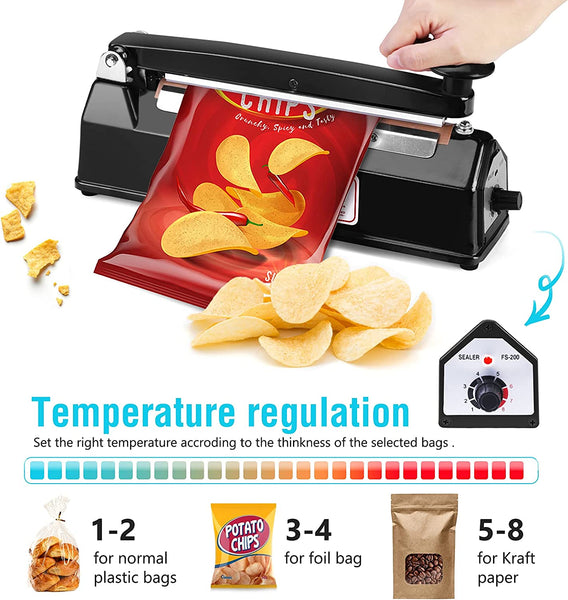Operating procedures of sealer
- Purpose:
Use the sealing machine correctly to ensure the normal and safe operation of the equipment.
- Scope:
Suitable for continuous sealing machine.
- Operation:
3.1 The operator must be familiar with the structure, performance, working principle and operation points of the sealing machine.

3.2 Mechanical and electrical group is responsible for the installation and acceptance of sealing machine, and timely organize personnel to repair and eliminate equipment failures.
3.3 The workshop supervisor is responsible for supervising the correct and reasonable use of the sealing machine and routine maintenance by the operator.
- Check before use:
4.1. This machine is equipped with two-pin socket with shell grounding, which should be well grounded during use to ensure safe production.
4.2. When it is used for the first time or the use interval is too long, the electric heating element will be affected with damp. After several minutes of low-temperature preheating, the electric heating element should be allowed to operate normally.
4.3. Adjust the height and front and rear positions of the conveying platform to meet the needs of packaging.
4.4. Adjust the position of the abutment (feed inlet) according to the external dimension from the sealing line to the bag opening.
4.5. According to the sealed material and thickness, adjust the gap between the upper and lower heating blocks and the upper and lower cooling blocks, and adjust the check piece to adjust the gap between the two sealing strips, which increases clockwise (increases the gap) and decreases counterclockwise (decreases the gap). The gap between the two sealing tapes is about the thickness of a layer of packaging bag, which not only ensures the sealing fastness and the clarity of knurling, but also does not make the two ends of the sealing part extend too long.
- Use:
5.1 Turn on the power supply and press the start switch, the indicator lights up, adjust the speed control knob, and all transmission parts will run synchronously.
5.2 Turn on the heating switch, and the green light of the electronic temperature controller will be on. Adjust the temperature controller to the required temperature according to the material and thickness of the packaging bag. When the heating block starts preheating, it should be turned on and run at low speed.
5.3 Depending on the material and thickness of the sealed plastic bag, determine whether it is necessary to turn on the fan for cooling. The sealing place of the packaging bag should be laid flat, and the mouth of the packaging bag should be fed in by the flat adjusting position (feed port). When the sealing place is bitten by the sealing tape, the packaging bag will automatically move forward. At this time, do not push or block it arbitrarily, or the sealing will be wrinkled or broken.
6, matters needing attention
6.1 Don't put your hand on the high-temperature cloth in the process of work to prevent your hand injury.
6.2 When dirt is found on the sealing tape and heating block, stop the machine and remove it. When the temperature is too high, do not remove it directly by hand.
6.3 Clean the surface every day, and do not be contaminated with dust.
6.4 It is forbidden to idle the equipment, and the machine must be turned off when no one works for a long time, so as not to waste resources.
- Handling methods of common faults
7.1 The seal is not firm.
Loose sealing is a common problem of continuous sealing machines, and the sealing of packaging bags cannot be closed. Such failures include the following:
7.1.1 If the heat sealing temperature is not enough, adjust the temperature appropriately according to the material and thickness of the packaging bag.
7.1.2 The speed of heat sealing is too fast, and it is also related to the speed of sealing machine. If the speed is too fast, the sealing part will be heated and will be sent to the cold pressing part by the traction wheel for cooling treatment, which will naturally fail to meet the requirements of heat sealing quality.
7.1.3 The pressure of the cold-pressed casters is not appropriate. There is one cold-pressed rubber wheel above and below, and the pressure between them should be moderate. When adjusting the pressure, just clamp the spring.
7.1.4 There is something wrong with the quality of the heat-sealing film. If the corona treatment of the composite lining is uneven and the effect is not good, Bin happens to appear at the sealing place, so it can't be sealed.
7.1.5 If there is water, dirt and material in the sealing place, it will not be sealed firmly.
7.2 Although the mouth of the bag is sealed, the seal will crack again if it is squeezed or torn slightly. Generally, there are the following points:
7.2.1 The surface of the heat sealing knife is uneven, and the upper and lower parts of the heat sealing knife are two pieces. There are three screws on the heat sealing knife, the middle screw plays a supporting and reinforcing role, the other two screws are equipped with springs and gaskets to relieve itching and adjust the heat sealing pressure, and the upper and lower blades have two springs respectively. The main reason for the uneven blade is that the middle screw is inclined. It's not horizontal, or the pressure spring of the heat sealing knife is uneven.
- Shutdown:
In order to prolong the service life of the sealing belt, it is required to return the temperature adjustment knob to the zero position and turn on the fan before turning off the machine. At this time, the temperature pointer starts to drop slowly, and the sealing belt should still be running. After several minutes, the temperature dropped to l00. C before turning off the fan and the main power switch.


